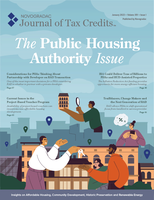How 2021 ACS Data Will Affect FY 2023 HUD Income Limits
Published by Thomas Stagg on Wednesday, January 4, 2023
When the U.S. Census Bureau announced in July 2021 that it would not release one-year American Community Survey (ACS) data for 2020, it set up an important question for low-income housing tax credit (LIHTC) owners, developers, investors and lenders: How will fiscal year (FY) 2023 income limits be determined?
That question was answered Dec. 2, 2022, when the U.S. Department of Housing and Urban Development (HUD) announced it will use 2021 ACS data to determine FY 2023 median family incomes and income limits for LIHTC properties. HUD said it would release FY 2023 information on or about May 15, which is about six weeks later than usual.
How Were Income Limits Determined in Previous Years?
HUD is required to set income limits annually. These rent limits are used to determine the maximum amount of rent property owners can charge for properties financed with the LIHTC or tax-exempt bonds. The income limits determine the maximum amount of income a household can have while still being eligible for LIHTC housing.
In recent years, HUD would set rent and income limits on ACS data from three years prior. However, data collection issues related to the COVID-19 pandemic caused the U.S. Census Bureau to announce that it would not release one-year ACS data for 2020. FY 2023 income limits would have ordinarily been based on the one-year 2020 ACS. Foreseeing the challenge, Novogradac formed the Income Limits Working Group in 2021 to recommend solutions to HUD for navigating the data collection issues.
According to the Novogradac Income Limits Working Group, if HUD has used five-year ACS data the area median income (AMI) limits would have been on average 3.5% lower than under the one-year ACS data. Put another way, income limits would have grown 3.5% slower than they otherwise would have. Using five-year ACS data would have decreased the number of households eligible for LIHTC housing. Thus, use of the one-year data for 2023 income limits pleased many members of the LIHTC community, including members of the Novogradac Income Limits Working Group.
What Factors Are at Play?
ACS data from 2021 will reflect the effect of COVID in 2021. The ACS data is collected throughout 2021 and will reflect the impact of COVID felt throughout the year. The ACS is also reported based on where people live and not where they work. Therefore, certain geographies will be impacted by the household movement that happened during COVID in certain areas. For example, the Census Bureau reported that the number of people who primarily worked from home tripled from 2019 to 2021.
What to Expect for 2023
Generally speaking, using the 2021 ACS will result in higher income limits for 2023 than if HUD used the 2020 five-Year ACS. Based on the most recent CPI information, we are estimating that national median income will increase by between 4.75%-5.0%. However, as always, some areas will have increases much larger than the national median and some areas will increase slower and even have decreases. As always, the ACS data for each area will be important.
What Happens for 2024?
Questions remain with respect to how HUD will handle 2024 income limits. Will HUD use 2021 data again? Will HUD use 2022 data? What CPI will be used? Join the Novogradac Income Limits Working Group to stay informed on income limits issues and participate in recommendations to HUD, including for 2024 income limits.

